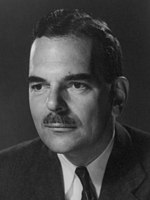| ||||||||||||||||||||||||||
All 12 Tennessee votes to the Electoral College | ||||||||||||||||||||||||||
|---|---|---|---|---|---|---|---|---|---|---|---|---|---|---|---|---|---|---|---|---|---|---|---|---|---|---|
| ||||||||||||||||||||||||||
 County Results
| ||||||||||||||||||||||||||
| ||||||||||||||||||||||||||
| Elections in Tennessee |
|---|
 |
|
|
The 1944 United States presidential election in Tennessee took place on November 7, 1944, as part of the 1944 United States presidential election. Tennessee voters chose 12[2] representatives, or electors, to the Electoral College, who voted for president and vice president.
For over a century after the Civil War, Tennessee was divided according to political loyalties established in that war. Unionist regions covering almost all of East Tennessee, Kentucky Pennyroyal-allied Macon County, and the five West Tennessee Highland Rim counties of Carroll, Henderson, McNairy, Hardin and Wayne[3] voted Republican – generally by landslide margins – as they saw the Democratic Party as the "war party" who had forced them into a war they did not wish to fight.[4] Contrariwise, the rest of Middle and West Tennessee who had supported and driven the state's secession was equally fiercely Democratic as it associated the Republicans with Reconstruction.[5] After the disfranchisement of the state's African-American population by a poll tax was largely complete in the 1890s,[6] the Democratic Party was certain of winning statewide elections if united,[7] although unlike the Deep South Republicans would almost always gain thirty to forty percent of the statewide vote from mountain and Highland Rim support.
In 1920 by moving into a small number of traditionally Democratic areas in Middle Tennessee[8] and expanding turnout due to the Nineteenth Amendment and powerful isolationist sentiment,[9] the Republican Party captured Tennessee's presidential electoral votes and won the governorship and three congressional seats in addition to the rock-ribbed GOP First and Second Districts; however, these gains were temporary because isolationist sympathy ebbed and turnout consequently fell.[10] Then in 1928 anti-Catholicism against Democratic nominee Al Smith in this powerfully fundamentalist state[11] meant that Herbert Hoover bettered Harding’s performance without however gaining significant down-ballot coattails.
Republican gains would be more than reversed in the 1930s due to the impact of the Great Depression, which was generally blamed upon the Republican Party’s policies during the 1920s. Internal divisions prevented the Republicans taking advantage of a disputed Democratic gubernatorial primary in 1932 between Lewis Pope and Hill McAlister,[12] and for the next third of a century the Republicans would rarely contest statewide offices seriously despite continuing dominance of East Tennessee and half a dozen Unionist counties in the middle and west of the state.[13] State politics became dominated by Edward Hull “Boss” Crump, whose Memphis political machine would consistently provide decisive votes in statewide Democratic primaries — aided by cross-party voting by Republicans in eastern mountain counties.[13] Crump would be supported during this era by long-serving Senator Kenneth Douglas McKellar, so that in 1938 when several statewide candidates allied themselves with Tennessee’s other Senator, Gordon Browning, the Crump/McKellar machine not merely defeated the collaboration, but even unseated Senator Browning.[14]
In April 1944, Smith v. Allwright ruled the white primary upon which the politics of most Confederate states was based unconstitutional. However, Tennessee’s history of substantial mountain Republican opposition meant it, like Oklahoma, North Carolina and Virginia, lacked statewide white primaries, although certain counties did use the white primary.[15] Consequently, local response to this landmark court case was generally calm;[15] nevertheless, there had already been a significant reaction to American involvement in World War II, in which Tennessee Senator Kenneth McKellar was a significant leader.[16]
- ^ "United States Presidential election of 1944 – Encyclopædia Britannica". Retrieved July 21, 2018.
- ^ "1944 Election for the Fortieth Term (1945-49)". Retrieved July 21, 2018.
- ^ Wright, John K. (October 1932). "Voting Habits in the United States: A Note on Two Maps". Geographical Review. 22 (4): 666–672. Bibcode:1932GeoRv..22..666W. doi:10.2307/208821. JSTOR 208821.
- ^ Key (Jr.), Valdimer Orlando; Southern Politics in State and Nation (New York, 1949), pp. 282-283
- ^ Lyons, William; Scheb (II), John M.; Stair, Billy (2001). Government and Politics in Tennessee. Univ. of Tennessee Press. pp. 183–184. ISBN 1572331410.
- ^ Phillips, Kevin P.; The Emerging Republican Majority, pp. 208, 210 ISBN 9780691163246
- ^ Grantham, Dewey W. (Fall 1995). "Tennessee and Twentieth-Century American Politics'". Tennessee Historical Quarterly. 54 (3): 210–229.
- ^ Reichard, Gary W. (February 1970). "The Aberration of 1920: An Analysis of Harding's Victory in Tennessee". The Journal of Southern History. 36 (1): 33–49. doi:10.2307/2206601. JSTOR 2206601.
- ^ Phillips; The Emerging Republican Majority, p. 211
- ^ Phillips; The Emerging Republican Majority, p. 287
- ^ Larson, Edward J. (October 3, 2006). Summer for the Gods: The Scopes Trial and America's Continuing Debate over Science and Religion. Basic Books. ISBN 9780465075102.
- ^ Majors, William R. (1986). Change and continuity: Tennessee politics since the Civil War. Mercer University Press. p. 65. ISBN 9780865542099.
- ^ a b Majors, Change and continuity, p. 72
- ^ Majors, Change and continuity, p. 70
- ^ a b Klarman, Michael J. (2001). "The White Primary Rulings: A Case Study in the Consequences of Supreme Court Decision-Making". Florida State University Law Review. 29: 55–107.
- ^ Phillips; The Emerging Republican Majority p. 288


